The first Shackerstone Family Festival was held in 1995, organised by members of the Ashby Canal Association, the Shackerstone Railway Society and Shackerstone Village, to raise money for national and local charities. It has been held each year since, raising all told an estimated 500,000 pounds for charity.
In 2007, my friend Keith was visiting from Australia when that year's Shackerstone Family Festival was held. Keith, John Archer and I attended as visitors on Sunday, 2nd September 2007, as described briefly here with a link to pictures of the various activities.
The 20th Anniversary Show was held on the 6th and 7th September 2014 and around 15,000 visitors were expected over the two days. In 2014, attractions in the Arena Field included Robin Hood and the Sheriff of Nottingham, Sheep Racing, Duck Herding, Tractor Pulling, a Wild West Show, Lawn Mower Grand Prix, Canine Obedience and Agility Demonstrations, Classic Car, Commercial and Vintage Bike Rally, Traction Engines, Traditional Children's Fun Fair and Ferris Wheel, Miniature Train Rides, a Beer Festival, Phase One Steel Band and Snibston Co-op Band. On the Ashby Canal, there was the usual Rally of Boats with Trips offered along the canal. In the air, there was a Spitfire display and an aerobatic display. And, of course, steam train rides from Shackerstone to Shenton. There's a short video of the 2014 event here.
The Battlefield Line and the Festival
The railway operated by Shackerstone Railway Society forms an important attraction for the Festival and I've been rostered as driver for a number of Festivals in previous years but I don't think they're described in this blog, apart from 2012 on when I was steam driver on the second day of that year's Festival. There's a rather incomplete report in the post A Busy Few Days
In 2014, I was rostered as the driver of '3803' on Sunday, 7th September 2014, with Steve. I didn't see much of the other attractions, apart from part of the Spitfire display and part of the aerobatic display by the Aerostars Aerobatic Display Team.
Preparation of 3803
The effectiveness of the firebox of a steam locomotive depends upon the condition of the firegrate. Like a domestic coal grate, the firegrate is usually cast iron provided with air spaces so that combustion air can pass upwards through the burning fuel and the incombustible remains of the coal, the ash, can drop downwards so as not to 'choke' the fire. In a locomotive this is normally achieved by having a series of specially-shaped cast bars called 'firebars' laid parallel in a rack with protrusions so as to leave air spaces between the bars. The life of a firebar is variable because they are operating in a hostile environment and 12 replacement firebars were available which Adrian fitted before we lit the new fire. This involved actually climbing inside the firebox (still warm from the previous day's running), wrestling out the rather mangled remains of the firebars to be replaced and slotting-in the new firebars. I never liked entering a warm firebox and I wouldn't attempt it now at my advanced age. But, thanks to Adrian, we now had a good-looking grate and the fireman, Steve, lit the fire with confidence. As expected, '3803' steamed well all day.
 Adrian fitting the new firebars in the firebox, still hot from the previous day's steaming
Adrian fitting the new firebars in the firebox, still hot from the previous day's steaming
I busied myself oiling round and doing the daily exam. I found one cork missing and Adrian found a replacement. Great Western engines are rugged. The two big cylinders (each 18.5 x 30 inches) develop a tractive effort at the railhead of 35,380 pounds - all transmitted through the two crankpins of the driving axle by the big ends of the connecting rods, so it's not surprising that generous bearing areas are provided on those crankpins.
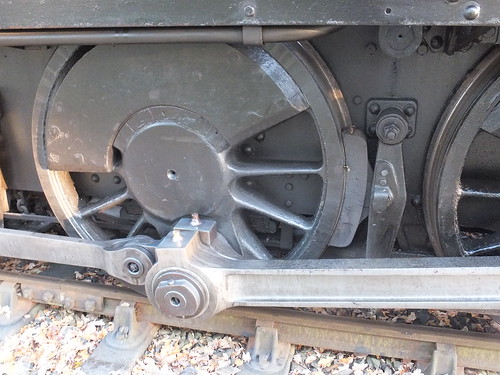 Right hand driving wheel and big end of connecting rod.
Right hand driving wheel and big end of connecting rod.
In Traffic
The Aveling Barford locomotive 'Blue Circle' was scheduled to be giving brake van rides during the day, so we had to wait for her to get steam up and shunt out of the way before we could come 'off-shed'. On the previous evening, there had been a 'Special' for the Exhibitors at the Festival so we found our 5-coach train was, unusually, stabled in Platform 1. In plenty of time, we gently shunted onto our train and coupled up.
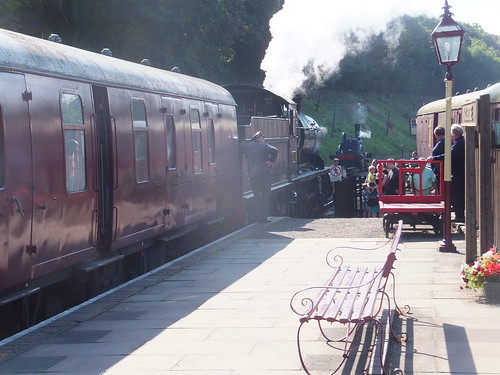 3803 ready to take the first departure from Shackerstone out of platform 1, with 'Blue Circle' in the background.
3803 ready to take the first departure from Shackerstone out of platform 1, with 'Blue Circle' in the background.
The weather was glorious and there were plenty of passengers so our first trip down the line to Shenton was very enjoyable as, indeed were all our trips. By the time we got back to Shackerstone, 'Blue Circle' had attached a brake van and was giving passenger rides on platform 1, so we were routed into platform 2. 'Blue Circle had to 'hide' up the Railcar Siding each time we used platform 1 to run-round our train.
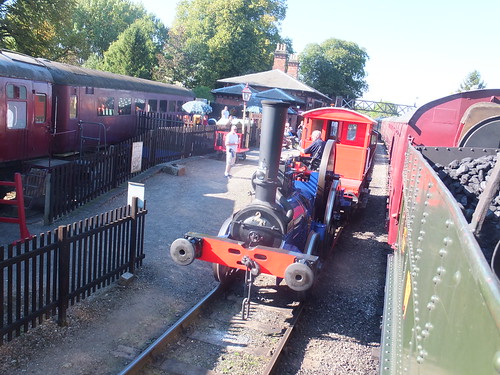 '3803' ready to depart for Shenton as 'Blue Circle' resumes brake van rides.
'3803' ready to depart for Shenton as 'Blue Circle' resumes brake van rides.
For a number of years, public access problems at Market Bosworth meant that passenger trains could not stop there. That's now resolved: access from the main road out of Market Bosworth is via the Station Drive where we have a large car park. There's then a foot crossing to reach the single platform operated by the railway. With a small cafe, shop and other displays the station is becoming increasingly popular and it's good to see a bit of 'bustle' returning to the place.
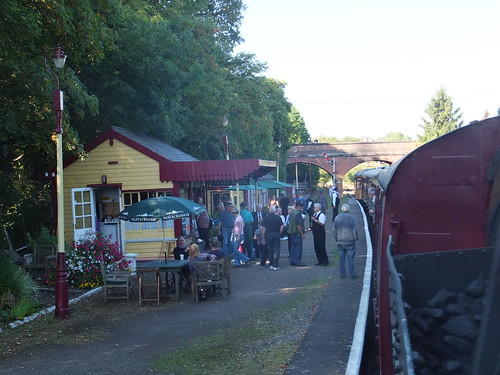 '3803' pauses at Market Bosworth.
'3803' pauses at Market Bosworth.
The day passed pleasantly and we were able to keep close to 'right time'. However, on the last return from Shenton, we were advised that a lineside fire had been spotted near Headley's Crossing. When the crossing came in sight, we could see smoke rising near the right side of the line. Once grass is dry, even a small spark from the chimney or a small piece of coal dropping from the ashpan can ignite a fire. If you're lucky, it will burn itself out once the grass is consumed but, otherwise, timber in the vicinity may create the risk of a serious conflagration. We stopped level with a small area of flame. A dousing with the Coal Watering Pipe soon made that safe and with Steve using a Fire Beater carried on the engine for the purpose and me wielding a firing shovel, we made sure the area was safe. Wooden railway sleepers, having usually been treated with creosote or similar chemicals to prevent rotting, can be quite difficult to extinguish once alight. Once we were satisfied that all was well, we clambered back on the engine, waited for a 'Right Away' from the Guard and finished our trip, only a few minutes late.
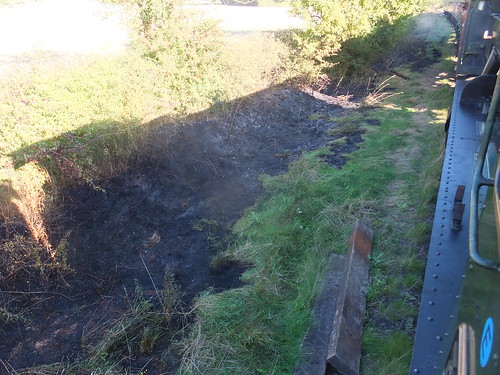 On the last trip, we stopped near Headley's Crossing to ensure a lineside fire was out.
On the last trip, we stopped near Headley's Crossing to ensure a lineside fire was out.
It only remained to shunt to the shed and dispose before 'signing off'. Steve and I agreed that we'd had a good day.
Other posts featuring '3803' in this blog
Another Busy Week.
Santa at Shackerstone.
A Day on the Footplate (1).
Battlefield Line Santa Specials 2011.
Summer Saturday with a '2884'.
My pictures
Shackerstone Family Festival 2014
